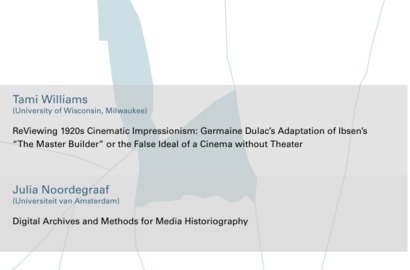Tami Williams about
ReViewing 1920s Cinematic
Impressionism: Germaine Dulac’s Adaptation of Ibsen’s “The Master
Builder” or the False Ideal of a Cinema without Theater
Belle Époque Paris was the epicenter of a diverse reevaluation and reconfiguration of suggestive forms
that galvanized the art world, bringing innovative musical
compositions, exhilarating dance forms, new pictorial models and
widespread theatrical renovation. Germaine Dulac, an early theater
critic, feminist filmmaker, and pioneer of an aesthetics of suggestion
and sensation, made over 30 fiction films, many marking new cinematic
tendencies, from impressionist to abstract. A look at the mid-1920s
genesis and context of her unrealized film adaptation of Ibsen’s iconic
theater play, The Master Builder-1892, renews our perspective of French
cinematic impressionism.
Dulac’s Solness le Constructeur/The Master Builder was written in mid-1920s Paris,
at the height of avant-garde calls for “cinematic specificity,” and
“pure cinema,” a conversation during which notions of “aesthetic
idealism” were playing out against “modernist skepticism,” as they had
for Ibsen prior. Yet, historical accounts of the 1920s French
avant-garde around issues of medium specificity, or the “false ideal” of
a cinema without theater, tend to erase a crucial distinction between
the traditional and the modern, boulevard theater and symbolist theater,
and obscure cinema’s assimilation of modern theater forms, exemplified
by Dulac’s Ibsenian adaptation.
Symbolist theater’s minimalist acting, its disjunction of word and image via off-scene narration,
and its emphasis on abstraction, suggestion, and sensation, are just a
few of the critical influences on the suggestive stylistic practices of a
socially progressive 1920s French art cinema. Taking inspiration from
her unrealized project, The Master Builder, and the Ibsenian notion of a
“false ideal,”—for Dulac, that of a cinema without theater, this essay
attempts to redress this historiographic disjuncture and to reestablish
the influence of Symbolist theatrical scenography and performance on
1920s French Impressionist cinema.
Tami Williams is Associate Professor of Film Studies and
English at the University of Wisconsin-Milwaukee, and president of
Domitor – the International Society for the Study of Early Cinema. She
is the author of Germaine Dulac: A Cinema of Sensations (2014),
co-editor of Global Cinema Networks (2018), editor of The Moving Image,
16.1: Early Cinema and the Archives (2016), and co-editor of Performing
New Media, 1895-1915 (2014). She also is a coordinator for the Women
Film Pioneers Project (France) and the Media Ecology Project: Library of
Congress Paper Print Pilot (Dartmouth).
Venue: Casino, Raum 1.811
Campus Westend, Goethe-Universität Frankfurt am Main
All Lectures are online here





